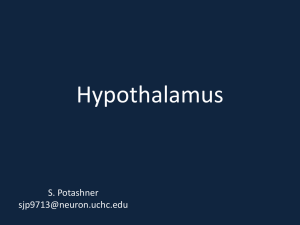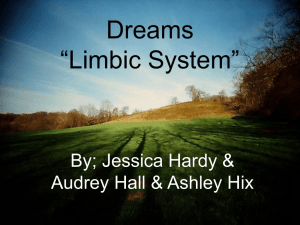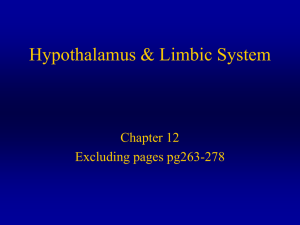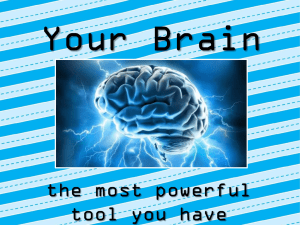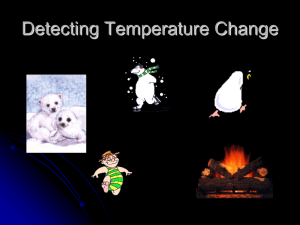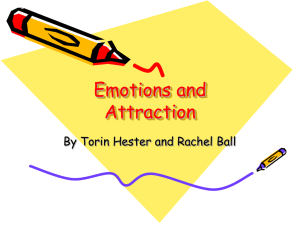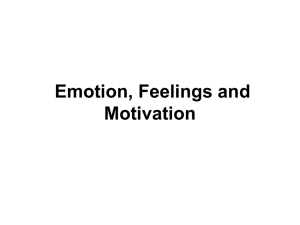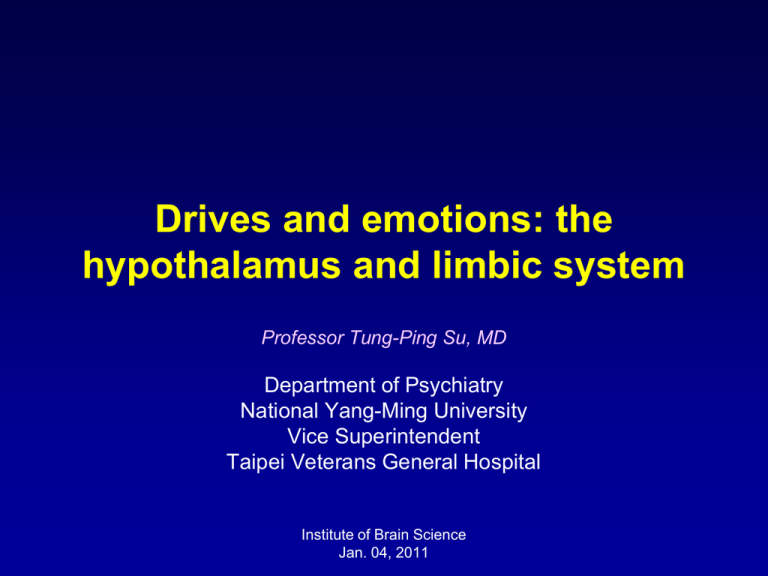
Drives and emotions: the
hypothalamus and limbic system
Professor Tung-Ping Su, MD
Department of Psychiatry
National Yang-Ming University
Vice Superintendent
Taipei Veterans General Hospital
Institute of Brain Science
Jan. 04, 2011
Drives and Emotions:
The hypothalamus and limbic system
Hypothalamus
• Subdivided in both longitudinal and medial-lateral directions
• Inputs from
– Forebrain arise in limbic structures
– The brainstem and spinal cord traverse the medial forebrain bundle and
dorsal longitudinal fasciculus
– Contains intrinsic sensory neurons
• Outputs largely reciprocate inputs
– Controls both lobes of pituitary lobes
• Perforating branches from the circle of Willis supply hypothalamus
• Hypothalamus collaborates with a network of brainstem and spinal
cord neurons
– Normal micturition involves a central pattern of generators in the pons
– Hypothalamus and associated central pattern generators keep
physiological variables within narrow limits
The role of hypothalamus: Connections
• Conscious awareness of physiological needs and social
situation (hungry but expansive) requires neocortex
• Limbic system includes:
– Cingulate, parahippocampal gyri and amygdala and
hippocampus
– Interpose between
hippocampus and neocortex
– Autonomic response and
voluntary movements
coordinates by hypothalamus
such as cutaneous
vasoconstriction & shivering
Figure 23-1 Three-dimensional reconstruction of the hypothalamus and surrounding cerebral structures. The hypothalamus
has been rendered with a flat anterior surface because the preoptic area (see Fig. 23-4), which envelops the anterior end of the
third ventricle but is in front of the plane sometimes used to separate the diencephalon and telencephalon, was not included. *,
claustrum; Am, amygdala; Ca, caudate nucleus; CC, corpus callosum; GP, globus pallidus; Hy, hypothalamus; IC, internal
capsule; In, insula; LVa, anterior horn of the lateral ventricle; P, putamen; Th, thalamus.
Downloaded from: StudentConsult (on 2 August 2009 11:00 AM)
© 2005 Elsevier
Figure 23-2 Overview of the pivotal role of the hypothalamus in drive-related activities. The hypothalamus can affect autonomic
motor neurons both directly and through visceral motor programs in the brainstem and spinal cord, and it can influence
visceral structures through its control over the pituitary gland (see Fig. 23-10). It can also stimulate somatic responses through
connections with limbic structures that interconnect the hypothalamus and neocortex. The latter are two-way connections,
providing us with a degree of voluntary control over responses that may be physiologically desirable but do not fit the current
circumstances in some other way (e.g., "grin and bear it"). The cerebellum and basal ganglia also have connections with the
hypothalamus, but their roles in the planning and coordination of drive-related activities are still poorly understood and are not
discussed in this chapter.
Downloaded from: StudentConsult (on 2 August 2009 11:00 AM)
© 2005 Elsevier
Hypothalamus coordinates drive-related
behaviors
• As a nodal point in the pathways concerned with
– Automonic, endocrine, emotional, and somatic functions
– To maintain our internal environment in a physiological range
– Functions extend into more complex interactions (drive and
emotional behaviors)
– A widespread set of connections: three principle categories:
1. interconnections with various parts of limbic system
2. outputs influences pituitary gland
3. interconnections with various visceral and somatic (both motor
and sensory) nuclei of brainstem and spincal cord
Inferior face of hypothalamus, exposed
directly to subarachnoid space, is bounded
By optic chiasm, the optic tr. post. edge of
Mammillary body
Hypothalamus
Figure 23-3 A, Regions of the hypothalamus and pituitary in midsagittal view. The entire area filled with diagonal lines is the tuber cinereum. The
crosshatched portion of the tuber cinereum is the median eminence. B, The medial surface of the hypothalamus. C, Myelin-stained parasagittal section of the
diencephalon, near the midline. D, Myelin-stained coronal section of the diencephalon and basal ganglia, showing the medial-lateral subdivision of the
hypothalamus. The dashed red lines in B and C indicate the transverse plane sometimes used as the diencephalon-telencephalon boundary; the area
between this plane and the lamina terminalis (the preoptic area) is considered here to be part of the hypothalamus. 3, third ventricle (optic recess in C); A,
anterior commissure; a, p, po, and t, anterior, preoptic, posterior, and tuberal regions of the hypothalamus; Ca, caudate nucleus; D, distal part of the
adenohypophysis; F, fornix; Fp, precommissural part of the fornix (see Fig. 24-17); G, great cerebral vein (of Galen); GPe, external segment of the globus
pallidus; GPi, internal segment of the globus pallidus; I, intermediate part of the adenohypophysis; IF, interventricular foramen; Inf, infundibulum; IS,
infundibular stalk; l, m, and pe, lateral, medial, and periventricular regions of the hypothalamus; LT, lamina terminalis; M, mammillary body (part of the
posterior hypothalamus); O or OC, optic chiasm; ON, optic nerve; OT, optic tract; Pi, pineal gland; PL, posterior lobe of the pituitary; Put, putamen; RN, red
Downloaded from: StudentConsult (on 2 August 2009 11:00 AM)
nucleus; SP, septum pellucidum; T, tuberal part of the adenohypophysis; TF, transverse fissure; Th, thalamus.
© 2005 Elsevier
Dorsal longitudinal fasciculus (DLF): a bundle of Hypothalamus afferents and efferents
SC:< 1 mm3 & <10000
Neurons, master clock
For circadian rhythm
Figure 23-4 Principal nuclei of the hypothalamus (most of the periventricular zone has been removed for clarity). *, lateral
terminalis; AC, anterior commissure; An, anterior nucleus; Ar, arcuate (infundibular) nucleus; CN, cranial nerve; DM,
dorsomedial nucleus; Inf, infundibular stalk; L, lateral nucleus; MB, mammillary body; Po, posterior nucleus; Pr, medial
preoptic nucleus; PV, paraventricular nucleus; SC, suprachiasmatic nucleus; SO, supraoptic nucleus; VM, ventromedial
nucleus. (Modified from Nauta WJH, Haymaker W: The hypothalamus, Springfield,
Ill, 1969, Charles C Thomas.)
Downloaded from: StudentConsult (on 2 August 2009 11:00 AM)
© 2005 Elsevier
Figure 23-5 Dependence of circadian rhythms on the suprachiasmatic nucleus. A, Wheel-running behavior of a hamster over a period of several months while living in
constant light. Each horizontal line represents a single day, and each thickening represents a period of wheel running. Wheel running starts out clearly rhythmic, with a
prominent episode approximately every 25 hours. On day 37 (arrow) the suprachiasmatic nucleus was destroyed bilaterally, and the wheel running subsequently became
almost random. B, Entrainment of circadian rhythms by environmental cues. These are the sleep records of a 22-year-old man living in a laboratory situation with no cues
about the time of day. Thick bars represent time asleep, and thin lines indicate time in bed but awake. For the first 20 days, the subject was awakened every 24 hours
and chose to go to bed at about the same time every day (without knowing what time it was). After day 20 he self-selected his own sleep time (i.e., his circadian rhythms
were allowed to run freely with no entraining cues). As a result, he went to bed about an hour later on each successive day; the free-running period was 25.3 hours.(A,
from Turek FW: Nature 292:289, 1981. B, from Czeisler CA et al: Sleep 4:1, 1981.)
Downloaded from: StudentConsult (on 2 August 2009 11:00 AM)
© 2005 Elsevier
Hypothalamus inputs arise in widespread neural sites
Froebrain & Limbic system; brainstem and spinal cord
& MPFC
& insula
To SCN
Raphe, LC & VTA
MLF--cortex
Figure 23-6 A, Major inputs to the hypothalamus. DLF, dorsal longitudinal fasciculus; MFB, medial forebrain bundle; ST, stria
terminalis; VAP, ventral amygdalofugal pathway (see Fig. 23-20). B and C, Location of the dorsal longitudinal fasciculus (DLF)
in the rostral pons and rostral medulla. 12, hypoglossal nucleus; MLF, medial longitudinal fasciculus; NST, nucleus of the
solitary tract; SCP, superior cerebellar peduncle; ST, solitary tract; X, dorsal motor nucleus of the vagus.
Downloaded from: StudentConsult (on 2 August 2009 11:00 AM)
© 2005 Elsevier
The hypothalamus contains intrinsic sensory neurons: sensitive to temp,
Glucose conce, blood osmolality, or certain hoemones
Figure 23-7 Patch-clamp recordings from a rat supraoptic neuron as it was exposed to hypertonic and hypotonic
solutions. Hypertonic solutions cause the neuron to shrink, mechanosensitive ion channels to open, and a burst of
action potentials. Hypotonic solutions cause the reverse. (From Oliet SHR, Bourque CW: Nature 364:341, 1993.)
Downloaded from: StudentConsult (on 2 August 2009 11:00 AM)
© 2005 Elsevier
Hypothalamus outputs largely reciprocate inputs
Similar to monoamine
Project pathways: 1)
Histaminergic fibers
From tuberomammilary Nu
2. Oriexinergic fibers
From tuberal and post.
hypothqalamus.
Mammillotegmental tr.
Efferent only
Figure 23-8 Major outputs from the hypothalamus. DLF, dorsal longitudinal fasciculus; ST, stria
terminalis; VAP, ventral amygdalofugal pathway (see Fig. 23-20).
Downloaded from: StudentConsult (on 2 August 2009 11:01 AM)
© 2005 Elsevier
Contrast of afferent and efferent
Reciprocial pathways of the
hypothalamus
M
Most fibers are
efferent
The final efferent pathways from the hypothalamus controls of both lobes of
Pituitary gland: most important functional part
Figure 23-9 Sagittal T1-weighted magnetic resonance image showing the anterior (green arrow) and posterior (blue arrow)
lobes of the pituitary gland. (Courtesy Dr. Elena M. Plante, University of Arizona.)
Downloaded from: StudentConsult (on 2 August 2009 11:01 AM)
© 2005 Elsevier
Neural projection
Arcurate Nu
ADH/vasopressin
Oxytocin
Releasing and
Inhibition hormones
Vascular link
Adenohypophysis
Have centers for
Feeding and drinking
Temperature regulation
Gut motility
Sex activity
Other functions
Figure 23-10 Routes by which the hypothalamus influences the pituitary gland. A, Oxytocin and
vasopressin are transported down the axons of magnocellular neurons of the supraoptic and
paraventricular nuclei, reaching capillaries of the posterior lobe. B, Parvocellular neurons in the arcuate
nucleus and nearby regions of the walls of the third ventricle secrete releasing and inhibiting hormones
in the median eminence, where they gain access to the hypophyseal portal system and, through it, reach
the anterior lobe. The inferior hypophyseal artery (not shown) also participates in the hypophyseal portal
system, giving rise to capillary sinusoids in the lower partDownloaded
of the from:
infundibulum.
StudentConsult (on 2 August 2009 11:01 AM)
© 2005 Elsevier
Hypothalamus collaborates with a network of brainstem and spinal cord
Nu of solitary tr.
Four prominent components
Related to drive-related behavior:
1. Nu of solitary tr.: taste &
visceral information
2. Parabrachial nucleus:
Visceral & sense of well-being,
effernt to thalamus, amygdala &
hypothalamus for drives and emotions
3. Ventrolateral reticular formation:
CV & resp. functions, swallowing,
micturition and defecation
4. Periaqueductal gray:
Origin of decending pain-control
pathway & orchestrates complex
responses, especially to threatening
Figure 23-11 Major patterns of connections of parts of the brainstem interconnected with the hypothalamus. A, The nucleus of
the solitary tract receives visceral afferents from cranial nerves (through the solitary tract [S]) and the spinal cord, and projects
to autonomic motor neurons in the dorsal motor nucleus of the vagus (X) and elsewhere and to central pattern generators. Its
outputs reach the hypothalamus and limbic system in part directly and in part through other nuclei such as the parabrachial
nuclei. B, The parabrachial nuclei (*) convey visceral, pain, and temperature information to the hypothalamus, thalamus (and
from there to the insula), and amygdala. C, Central pattern generators for coordinated autonomic and somatic responses to
physiological challenges are located in the reticular formation. Those in the ventrolateral rostral medulla are important for
cardiovascular and respiratory responses. D, The periaqueductal gray orchestrates complex responses, especially to
threatening situations, guided by inputs from the cerebrum. ANS, autonomic nervous
system;
SCP, superior
cerebellar
Downloaded
from: StudentConsult
(on 2 August
2009 11:01 AM)
© 2005 Elsevier
peduncle.
Long periods of storage mode
1. Sympathetic inputs & lack of
parasympathetic activity
Alternating with short periods of elimination
Onuf’s nu
Activated, while sympathetic and Onuf’s nu
are inhibited
(Lower motor neuron)
Figure 23-12 Spinal cord control of the lower urinary tract. As the bladder fills (left side of figure), intravesical pressure is
minimized by T11-L2 preganglionic sympathetic neurons (1) that synapse on postganglionic neurons (2) in the inferior
mesenteric ganglion; these in turn inhibit postganglionic parasympathetic neurons in the bladder wall (3). Outflow resistance
is high because lower motor neurons in Onuf's nucleus (4) activate the external sphincter, and sympathetics activate smooth
muscle in the bladder neck (5). During elimination mode (right side of figure), all this is reversed. Sympathetics and sphincter
motor neurons slow down or fall silent, reducing outflow resistance. Sacral preganglionic parasympathetic neurons (6)
synapse on postganglionic neurons (7) in the bladder wall; these in turn activate the detrusor, increasing intravesical pressure.
Downloaded from: StudentConsult (on 2 August 2009 11:01 AM)
© 2005 Elsevier
Micturition circuitry
descending
connections
Ascending
connections
PMC: Pontine
micturition center
Sympathetic
parasympathetic
Figure 23-13 Neural connections involved in normal micturition. To simplify the diagram, ascending connections are shown on
the left and descending connections on the right; in reality, both are bilateral. Tension receptors in the bladder wall (1) project
to interneurons subserving the vesicovesical reflex (2), which has little effect in normal adults. The same primary afferents also
synapse on tract cells (3) that convey information about bladder fullness to the periaqueductal gray (PAG), hypothalamus (Hy),
and thalamus (Th) and from there to visceral sensory cortex in the insula (Ins). The periaqueductal gray integrates sensory
inputs, inputs from the hypothalamus, and cortical inputs representing activity in prefrontal (PF) and limbic (cingulate gyrus;
CG) areas. Periodically, the periaqueductal gray activates the pontine micturition center (PMC), which in turn inhibits
sympathetic (4) and lower motor neurons (5) to the bladder and activates parasympathetics (6) to the detrusor.
Downloaded from: StudentConsult (on 2 August 2009 11:01 AM)
© 2005 Elsevier
Figure 23-14 Compilation of data from five functional imaging studies, showing areas activated when subjects perceived their
bladders to be full (vs. empty). ACG, anterior cingulate gyrus; DLPFC, dorsolateral prefrontal cortex; PAG, periaqueductal gray;
PMC, pontine micturition center. (Adapted from Kavia RBC, DasGupta R, Fowler CJ: J Comp Neurol 493:27, 2005. Prepared
using MRIcro software; Rorden C, Brett M: Behav Neurol 12:191, 2000.)
Downloaded from: StudentConsult (on 2 August 2009 11:01 AM)
© 2005 Elsevier
Hypothalamus and associated central pattern
generators keep physiological variables
within narrow limits
•
Physiological variables: keep it within narrow limits
– Temperature, pH, water & glucose concentrations & others
– Maintain value referred to a set point , like a thermostat, a homeostatic
processes
– Temperature regulation: 37C (neurons in medial preoptic nu are warm-sensitive,
excite central pattern generator for heat dissipation)
– Water regulation by the other gp of neurons of medial preoptic neurons:
Osmolality---osmoreceptor neurons at lamina terminalis, ADH secreting neurons
– Regulation of food intake and energy balance: feedback signals togather with
coordinated endocrine, autonomic & behavioral responses
Satiety center (ventro-medial tuberal hypothalamus VMT): bil lesions ---too fat
Feeding center (Lateral hypothalamus): lesions: do not eat ---starvation to death
– Two hormones: Ghrelin & leptin: abnormalities ---for both signals ---obesity
Ghrelin: secreted by stomach with increased rate after meal, bind to arcurate nu
to stimulate feeding behavior and energy storage
Leptin: produced by adipocyte---opposite effect.
– Fat and rage cat
Limbic structures are interposed between the
hypothalamus and neocortex
1878 Paul Broca:
• Limbic (border) lobe – related to sense of
smell (olfactory)—was disproved later
•
1937 James Papez proposed as an anatomic
Substrate for drives and emotional behavior
• suggest cingulate gyrus and its widespread
neocortical connections are the basis for
experiencing emotions
• But now amygdala and its connections are
more centrally involved in emotional
experiences while hippocampus: learning
& memory
• Limbic system:
Parahippocampus, cigulate, amygdala &
hippocampus, septal nu, hypothalamus,
part of midbrain reticular formation &
olfactory areas
Like tennis racket
Two major limbic subsystems: amygdala & hippocampus
Figure 23-15 Three-dimensional re-construction of the hippocampus, fornix, and amygdala inside a
translucent CNS, seen from the left (A), in front (B), above (C), and behind (D).
Downloaded from: StudentConsult (on 2 August 2009 11:01 AM)
© 2005 Elsevier
Limbic formed a complete ring of cortex
Hippocampus subsystem:
• utilizes post. Cingulate &
parahippocampal cortex to
liasion with neocortex
• Close relation with ant.
Thalamic nu and
mammillary body
Amygdala : part of uncus
Ventromedial PFC
Anterior temporal &
Insula cortex
• Close relation with dorsal
medial nu of thalamus (DM)
• Continuous core of neural
tissue to the septal area thru
hypothalamus & into midbrain
reticular formation
Figure 23-16 Limbic areas of cortex.
Downloaded from: StudentConsult (on 2 August 2009 11:01 AM)
© 2005 Elsevier
Medial nu:
• Interconnected with olfactory sys.
Central nu:
• interconnected with the
hypothalamus and related
brainstem nu (PAG)
Basolateral nu: the largest part
• continuous with parahippocampal
cortex
• extensively interconnected with
cortical areas
Figure 23-17 Subdivision of the amygdala into basolateral (BL), central (C), and medial (*) nuclei. The
basic pattern of connections of the basolateral and central nuclei is indicated. PH, parahippocampal
gyrus.
Downloaded from: StudentConsult (on 2 August 2009 11:01 AM)
© 2005 Elsevier
Major inputs to the amygdala, receiving a wide variety of sensory inputs
Figure 23-18 Major inputs to the basolateral (blue), central (red), and medial (green) nuclei of the amygdala (Am). Only inputs
from visual association cortex to the basolateral nuclei are shown, although there are similar projections from most or all
unimodal sensory areas. The inputs from limbic cortex to the basolateral nuclei also include a major projection from the insula,
which is not present in this view. B, brainstem (periaqueductal gray, parabrachial nuclei, other nuclei); Hy, hypothalamus; S,
septal nuclei; T, thalamus (multiple nuclei). (Modified from Warwick R, Williams PL: Gray's anatomy, Br ed 35, Philadelphia,
1973, WB Saunders.)
Downloaded from: StudentConsult (on 2 August 2009 11:01 AM)
© 2005 Elsevier
Amygdala projects to the cerebral cortex and hypothalamus
Figure 23-21 Major outputs from the basolateral (blue), central (red), and medial (green) nuclei of the amygdala (Am). These
take three routes: (1) the stria terminalis, which reaches the septal nuclei (S) and hypothalamus (Hy); (2) the ventral
amygdalofugal pathway (see Fig. 23-20B and C) to the hypothalamus (Hy), thalamus (T; mainly the dorsomedial nucleus),
widespread areas of ventromedial prefrontal and insular cortex, ventral striatum (VS), olfactory structures, and various
brainstem sites (B); and (3) direct projections to the hippocampus (HC) and temporal and other neocortical areas. Only visual
cortical areas are shown, although there are similar projections to most or all primary and unimodal sensory areas. (Modified
Downloaded
from:Saunders.)
StudentConsult (on 2 August 2009 11:01 AM)
from Warwick R, Williams PL: Gray's anatomy, Br ed 35, Philadelphia,
1973, WB
© 2005 Elsevier
Amygdala projects to the ventral striatum and ventral pallidum
Limbic connection with basal ganglia (drive-related information
Can influence decisions about movements (stimuli & rewards)
Figure 23-22 Overview of the limbic loop through the basal ganglia. Only major connections are
indicated, although others are known. For example, there are direct projections from the ventral striatum
to the hypothalamus and amygdala. Excitatory connections are shown in green, inhibitory connections in
red. VP, ventral pallidum; VS, ventral striatum.
Downloaded from: StudentConsult (on 2 August 2009 11:01 AM)
© 2005 Elsevier
Figure 23-23 Mapping the distribution of a particular type of dopamine receptor (D3 receptor) that has been implicated in
reward circuitry, using a radioactive ligand. In coronal sections of normal brain (A to D) the receptor is preferentially localized
in the ventral striatum, particularly the nucleus accumbens (NA). In the brain of a chronic cocaine user who died of a cocaine
overdose (E), this preferential distribution is even more pronounced. The color bar at the lower right shows the color coding of
receptor density, measured as radioligand binding (fmol/mg). Cd, caudate nucleus; GP, globus pallidus; Hipp, hippocampus;
Hyp, hypothalamus; Pt, putamen; sn, substantia nigra; th, thalamus. (From Staley JK, Mash DC: J Neurosci 16:6100, 1996.)
Downloaded from: StudentConsult (on 2 August 2009 11:01 AM)
© 2005 Elsevier
Amygdala is involved in emotion-related aspects of learning
Figure 23-24 Axial MRI scan of the 52-year-old physician described in Box 23-2, showing damaged areas in the left (red arrow)
and right (green arrow) occipital lobes and increased blood flow in the right amygdala as he looked at pictures of angry, sad, or
frightened faces. (From Pegna AJ et al: Nat Neurosci 8:24, 2005.)
Downloaded from: StudentConsult (on 2 August 2009 11:01 AM)
© 2005 Elsevier
Figure 23-25 Areas of increased blood flow, measured by fMRI, in subjects watching videotapes of the faces of patients in pain (A) and themselves receiving a painfully
hot stimulus (B). In both conditions, there was activation of medial prefrontal cortex (A1-2, B1-2) and the insula (A3, B3). Only when watching the faces of others in pain
was there activation of the face-recognition area in the right occipitotemporal gyrus (A4, green arrow) and the left amygdala (A4, red arrow). The lateral cerebellum was
also activated in both conditions (A5, B5), consistent with this structure's role in more than just movement (see Chapter 20). (From Botvinick M et al: NeuroImage 25:312,
2005.)
Downloaded from: StudentConsult (on 2 August 2009 11:01 AM)
© 2005 Elsevier
Figure 23-26 Regulation of emotions by conscious effort involves both dorsolateral and ventromedial prefrontal cortex. Ten young male subjects (average age 23.5
years) watched erotic films in two different conditions. In one (A) they were instructed to relax and react normally, and in the other (B) they were instructed to suppress
any sexual feelings. Subjects in the first condition reported sexual arousal, and fMRI demonstrated increased blood flow in the right temporal pole (A1), right amygdala
(A2), and hypothalamus (A3). Subjects in the second condition reported much lower levels of sexual arousal, and fMRI demonstrated no increased blood flow in any of
these areas (B1-3). However, in the second condition, blood flow did increase in the right dorsolateral prefrontal (C1) and anterior cingulate (C2) cortex. (From
Beauregard M, L&#233;vesque J, Bourgouin P: J Neurosci 21:RC165, 2001.)
Downloaded from: StudentConsult (on 2 August 2009 11:01 AM)
© 2005 Elsevier
Figure 22-26 The probable relationship between Phineas Gage's brain and the tamping iron, based on a modern reexamination of his skull and the entry and exit
wounds. Ventrolateral prefrontal areas were heavily damaged, but motor cortex, Broca's area, and most dorsolateral prefrontal areas were probably spared. (From the
cover illustration accompanying Damasio H et al: Science 264:1102, 1994.)
Downloaded from: StudentConsult (on 2 August 2009 10:55 AM)
© 2005 Elsevier
Thanks for your patience
Sites of damage and aphasia sx
in 101 stroke patients
The thalamus and internal capsule:
getting to and from cerebral cortex
Chapter 16
Figure 23-19 Psychophysical testing and functional imaging during stimulation of C-touch receptors. A, Detection of various
stimuli by patient GL (Box 23-1) and control subjects; the dashed line indicates a chance level of detection. B, Rating of the
intensity and pleasantness of gentle brushing by GL and control subjects. GL rated both intensity and pleasantness the same
as controls did when the stimulus was applied to her forehead (where innervation was still normal). The same stimulus was
perceived as equally pleasant but less intense when applied to her forearm. C to F, Functional MRI demonstration of areas
activated in GL (C and E) and control subjects (D and F) during gentle brushing of the forearm. Ins, insula; PMC, premotor
cortex; S1, primary somatosensory cortex; S2, second somatosensory area. (From Olausson H et al: Nat Neurosci 5:900, 2002.)
Downloaded from: StudentConsult (on 2 August 2009 11:01 AM)
© 2005 Elsevier
Figure 23-20 Location of the amygdala and related fiber bundles. A, Three-dimensional reconstruction with the planes of section shown in B, C, and D indicated. 3, third
ventricle; 4, fourth ventricle; A, anterior thalamic nucleus; AC, anterior commissure; Am, amygdala; C, caudate nucleus; CP, cerebral peduncle; DSCP, decussation of the
superior cerebellar peduncles; F, fornix; GP, globus pallidus; GPe, external segment of globus pallidus; GPi, internal segment of globus pallidus; H, tuberal
hypothalamus; HC, hippocampus; IP, interpeduncular cistern; LV, lateral ventricle (inferior horn); M, mammillary body; MT, mammillothalamic tract; O, optic tract; P,
putamen; SN, substantia nigra; TF, transverse fissure. (A, prepared by Cheryl Cotman. A to D, modified from Nolte J, Angevine JB Jr: The human brain in photographs
and diagrams, ed 3, St. Louis, 2007, Mosby.)
Downloaded from: StudentConsult (on 2 August 2009 11:01 AM)
© 2005 Elsevier

